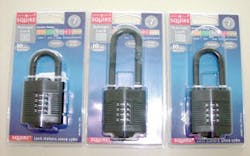The Beatles came in 1965 and in 2005 we have Squire padlocks. Both of these United Kingdom exports have the same qualities of British flair and imagination long appreciated by the American public. While Squire padlocks may not currently be a U.S. household name like the Beatles, the products we reviewed for this article should quickly become favorites.
Henry Squire & Sons have been in the lock business since 1780. Older Squire padlock designs used a bit key and multiple locking levers. Most of the Squire locks arriving in the USA today are modern, keyless, heavy duty recodable padlocks with four locking wheels.
Squire has three versions of its #CP1 recodable combination padlocks (image 1). All three lock types share the same lock body but have different length shackles. When measured vertically from the lock body to the shackle loop, shackle lengths are approximately 1”, 1.5” and 2.5” respectively. Shackle diameters on all three models are approximately 5/16”. The die-cast lock bodies are zinc plated and have a protective black coating for corrosion resistance.
A fourth recodable padlock model CP1CS uses a closed or ‘shielded’ shackle (image 2). The shield is held on with a Philips retaining screw. When the padlock is fastened onto a hasp or chain, the shield cannot be removed. The shield can easily be unfastened when the padlock is in an unlocked position for combination changing.
Numbering on these recodable padlock dials ranges from 1 to 8, which allows more than 4,000 different combinations.
Locks are set with a factory code of 1111. The first step in unlocking a Squire lock is to revolve the wheels to the correct combination. Notched sections on each wheel provide a gripping surface for easily turning each wheel. Once the wheels are turned to the correct combination, a button located on the bottom of the housing must be depressed which then causes the shackle to automatically spring open.
Relocking is accomplished by resetting the shackle into the lock body and then scrambling the wheels to any incorrect combination.
Padlocks come packaged with a special ‘U’ shaped combination changing tool. An oblong rotating cap covering the change tool access holes is located between the shackle legs (image 3). The cap can only be fully turned to reveal to change tool access holes when the padlock is unlocked and the shackle is turned out of the way (image 4). Once the ‘U’ shaped change tool is inserted (image 5), it must be held inward against spring pressure while the dials are rotated to a new combination.
A unique security rating number system is included on each Squire padlock package (image 6). Squire rates their various padlocks from 1 to 15. Ratings on the recodable padlocks are in the ‘7’ mid-range. This rating system helps eliminate concerns about purchasing by price and instead directs customers toward choosing the security level they desire.
Squire markets many other security products including Old English padlocks (image 7), Combi bolts (image 8) and high security combination padlocks (image 9). Current plans call for distributing only the CP1 line of recodable padlocks in the United States.
According to Squire U.S.A. sales manager Kenneth Erickson, Clark Security has been designated as the exclusive distributor of Squire padlocks for the United States market.
For further information, contact: Squire U.S.A., Phone: 815-857-4330. Fax: 815-857-4340. E-Mail: [email protected].
